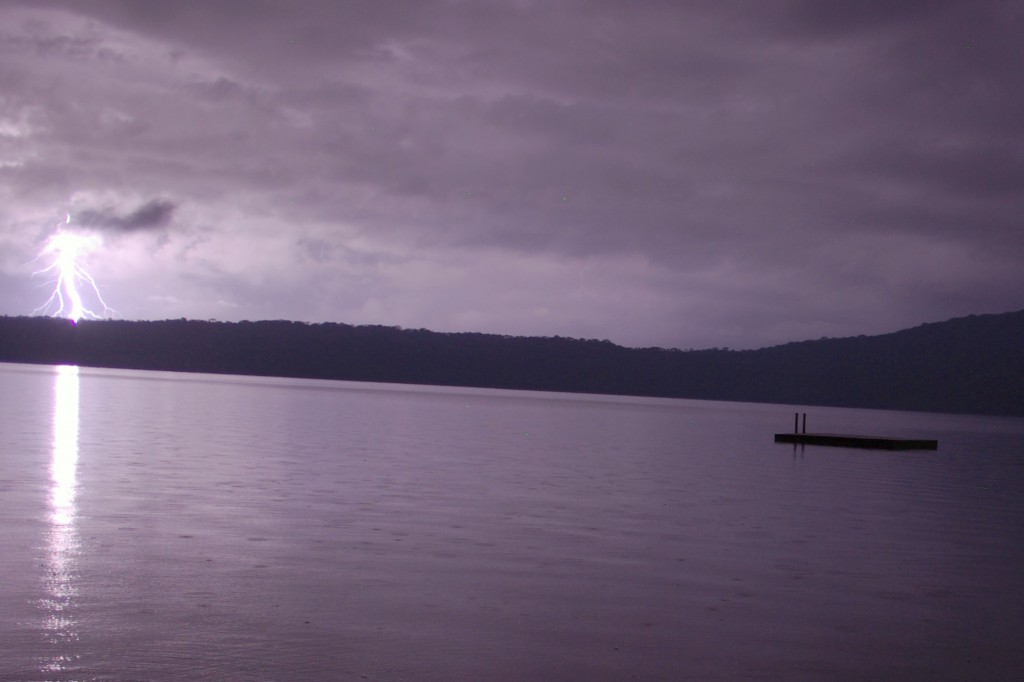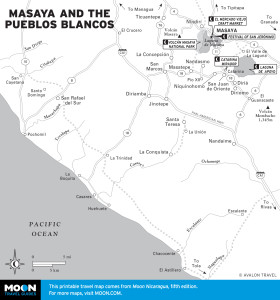Nicaragua’s cleanest and most enticing swimming hole is Laguna de Apoyo, just outside of Masaya. Actually a lake that formed in the drowned volcanic crater of the long extinct Apoyo Volcano, the lagoon floor reaches 200 meters in depth—the lowest point in all of Central America. Considering how easy it is to reach the lagoon, it is surprisingly untouristed.
Despite its continued seismicity—a minor earthquake in 2000 under the crater-rim town of Catarina caused Apoyo’s water to slosh back and forth like a teapot and wrecked a few homes—for the most part the volcano is considered dormant, and a thick green forest has grown up the slopes over the years.

A dramatic lightning strike lights up Laguna de Apoyo.
Photo by Adam Baker licensed Creative Commons Attribution.
These slopes harbor a few hiking trails and are protected from further development by law. The crater hosts a few fish species found nowhere else on earth; scientists at the Proyecto Ecologico are studying them.
If you hike through the forests, expect to observe species of toucan, hummingbirds, blue jays, howler and white-face monkeys (which are prone to fling their feces at you if you approach), and rare butterflies. You will find very few places on earth quite like this charming, isolated community.

Masaya and the Pueblos Blancos
Laguna de Apoyo is about a 20-minute ride from either Masaya or Granada, and about an hour from the airport in Managua. There are two paved roads that go up and over the crater lip and down to the water’s edge; one originates on Carretera Masaya, at a spot called el puentecito; the other branches off the Masaya–Catarina road. They join just before passing through the village of Valle de Laguna, where you’ll turn right at the T then make a quick left to begin your descent (pay a $1 entrance fee if driving). The road winds downward until the paved section ends exactly at the gate to former president Alemén’s vacation home.
Regular backpacker buses leave Hostel Oasis and the Bearded Monkey in Granada, charging about $10 return. Or share a taxi from Granada or Masaya for about $20.
Public buses headed for bajo al plan (i.e., lakefront) cost under $1 and leave the main Masaya market terminal at 10:30 a.m. and 3:10 p.m.; or you can hop one of the hourly buses for Valle de Laguna, then walk (30 minutes downhill) or wait for a stray taxi.
Mototaxis run between the puentecito and Valle de Laguna. Three public buses can get you back up the hill, leaving at 6 a.m., 11:10 a.m., and 4:40 p.m. (3 p.m. on Sunday is the last bus).
The area has no stores or shops and few services, so either pack your essentials before coming, or count on one of the local hotels or restaurants. Most hotels offer cheap shuttles from Granada, or you can hire a taxi or take a bus.
The Monkey Hut (100 m north of the triangle, 505/8887-3546, [email protected]) is a well-liked retreat on a beautiful terraced piece of land at the water’s edge, with a small selection of rooms and fully equipped kitchen. Soft drinks, water, wine, and beer can be purchased at the hut; all other supplies need to be packed in.
Next door, Hostel Paradiso (505/8187-4542, [email protected]) is also geared towards budget travelers, offering terraced patios, waterside bar, floating dock, and free kayak use for guests. Use the open kitchen or opt for meals at the restaurant. There is wi-fi, and local crafts are for sale. Arrange transport here through the Oasis Hostel in Granada.
The Proyecto Ecologico Spanish School and Hostel (505/8882-3992), a non-profit research station and Spanish school, is one of the oldest operations in the crater. They organize bird-watching, hikes, scuba diving expeditions ($60 for two tanks), and the chance to participate in a volunteer reforestation brigade; all-inclusive Spanish school packages start at $220 per week. There is nowhere better to speak with knowledgeable ecologists who can help interpret this unique region, and the home-cooked meals ($5) are recommended.
At “Grandma’s” Posada Ecologica La Abuela (505/8880-0368, [email protected]) you’ll find a series of wooden docks, rocker swings for splashing around in the water, and great views. The wooden cabañas are very comfortable and well appointed, with air-conditioning, private bath, nice mattresses; there are also great facilities for groups.
Neither hostel nor hotel, Guest House La Orquidea (505/8872-1866) is a stylish two-bedroom house, fully equipped for a relaxing stay; features include a gorgeous balcony, boats, and water toys. Rates run $120 a night for 4-7 guests, healthy breakfast provided; there is also a separate room for $40.
On the opposite end of the road, San Simian Eco-Resort (505/8813-6866, [email protected]) is a lovely waterside group of five private bungalows, each of which has a slightly different theme built from natural materials like thatch and bamboo. The tasteful, rustic rooms have bamboo beds with comfy mattresses, mosquito nets, fans, and fun outdoor showers and gardens. Amenities include great on-site meals, a bar, and a relaxing dock with water toys. Nearby trailheads lead up into the jungle and along the shore.
New management has taken over Norome Resort and Villas (505/2552-8200, U.S. or Canada tel. 760/494-7331) and is bringing the property’s 66 Caribbean-style villas back to glory. Apartments and suites (1–3 bedrooms) have hot water, bathtubs, air-conditioning, TV/DVD, and kitchenettes. The restaurant and bar perched over the water are stunning ; wi-fi is available. Relax by the lakeshore and swimming pools, book a massage, or go boating, biking, and hiking. Day-trippers are welcome with a $5 minimum purchase at the restaurant.
Excerpted from the Fifth Edition of Moon Nicaragua.